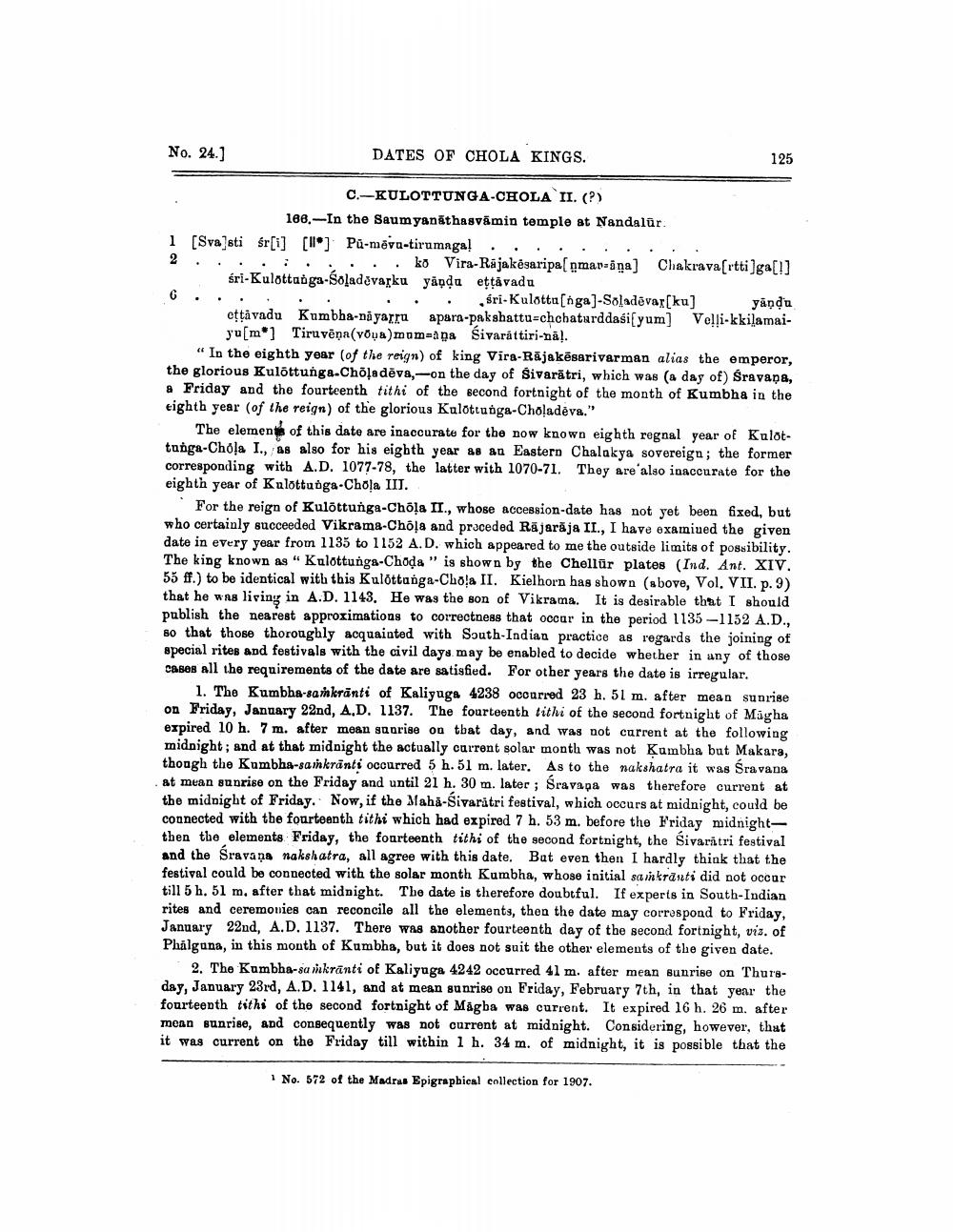________________
No. 24.]
DATES OF CHOLA KINGS.
C.-KULOTTUNGA-CHOLA II. (?)
168.-In the Saumyanathasvamin temple at Nandalür.
1 [Svasti fr[] [] Pü-mera-tirumagal
2
125
ko Vira-Rajakaripal marga) Chakrava[i][1] śri-Kulottanga-Soladavarku yanḍu eṭṭavadu
śri-Kulottu[nga]-Soladevar[ku]
yaṇḍu eṭṭavadu Kumbha-nayarru apara-pakshattu-chchaturddasifyum] Velli-kkilamaiyu[m] Tiruvena (voua) mum-apa Śivarattiri-nal.
"In the eighth year (of the reign) of king Vira-Rajakēsarivarman alias the emperor, the glorious Kulottunga.Chola deva,-on the day of Sivaratri, which was (a day of) Sravana, a Friday and the fourteenth tithi of the second fortnight of the month of Kumbha in the eighth year (of the reign) of the glorious Kulottunga-Choladeva."
The elements of this date are inaccurate for the now known eighth regnal year of Kulottunga-Chola I., as also for his eighth year as an Eastern Chalukya sovereign; the former corresponding with A.D. 1077-78, the latter with 1070-71. They are also inaccurate for the eighth year of Kulottunga-Chola III.
For the reign of Kulottunga-Chōla II., whose accession-date has not yet been fixed, but who certainly succeeded Vikrama-Chola and proceded Rajaraja II., I have examined the given date in every year from 1135 to 1152 A.D. which appeared to me the outside limits of possibility. The king known as " Kulottunga-Choda" is shown by the Chellur plates (Ind. Ant. XIV. 55 ff.) to be identical with this Kulottunga-Chola II. Kielhorn has shown (above, Vol. VII. p. 9) that he was living in A.D. 1143. He was the son of Vikrama. It is desirable that I should publish the nearest approximations to correctness that occur in the period 1135-1152 A.D., so that those thoroughly acquainted with South-Indian practice as regards the joining of special rites and festivals with the civil days may be enabled to decide whether in any of those cases all the requirements of the date are satisfied. For other years the date is irregular.
1. The Kumbha-samkranti of Kaliyuga 4238 occurred 23 h. 51 m. after mean sunrise on Friday, January 22nd, A.D. 1137. The fourteenth tithi of the second fortnight of Magha expired 10 h. 7 m. after mean sunrise on that day, and was not current at the following midnight; and at that midnight the actually current solar month was not Kumbha but Makara, though the Kumbha-samkranti occurred 5 h. 51 m. later. As to the nakshatra it was Śravana at mean sunrise on the Friday and until 21 h. 30 m. later; Śravapa was therefore current at the midnight of Friday. Now, if the Maha-Sivaratri festival, which occurs at midnight, could be connected with the fourteenth tithi which had expired 7 h. 53 m. before the Friday midnightthen the elements Friday, the fourteenth tithi of the second fortnight, the Sivaratri festival and the Śravana nakshatra, all agree with this date. But even then I hardly think that the festival could be connected with the solar month Kumbha, whose initial samkranti did not occur till 5 h. 51 m. after that midnight. The date is therefore doubtful. If experts in South-Indian rites and ceremonies can reconcile all the elements, then the date may correspond to Friday, January 22nd, A.D. 1137. There was another fourteenth day of the second fortnight, vis. of Phalguna, in this month of Kumbha, but it does not suit the other elements of the given date.
2. The Kumbha-samkranti of Kaliyuga 4242 occurred 41 m. after mean sunrise on Thursday, January 23rd, A.D. 1141, and at mean sunrise on Friday, February 7th, in that year the fourteenth tithi of the second fortnight of Magha was current. It expired 16 h. 26 m. after mean sunrise, and consequently was not current at midnight. Considering, however, that it was current on the Friday till within 1 h. 34 m. of midnight, it is possible that the
1 No. 572 of the Madras Epigraphical collection for 1907.




